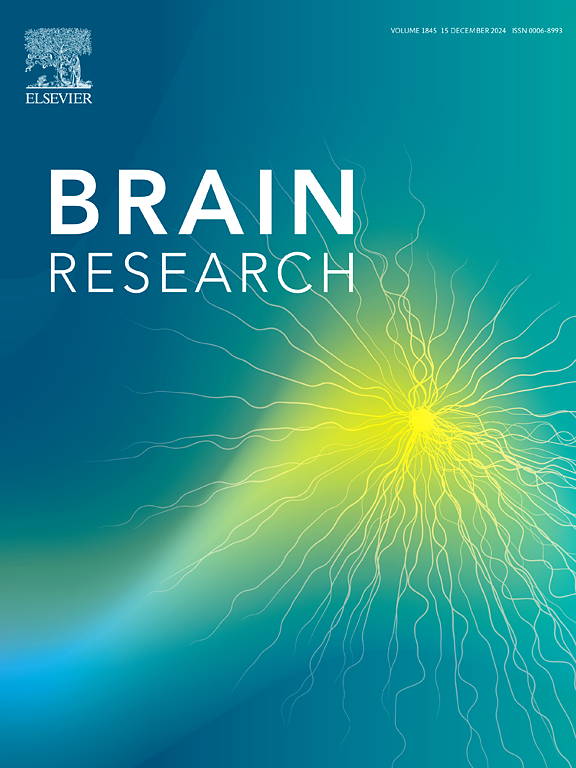飞镖快速学习会降低θ功率,但不受 Hf-tRNS 的影响:一项行为学和电生理学研究。
IF 2.6
4区 医学
Q3 NEUROSCIENCES
引用次数: 0
摘要
最近,体育教练对包括经颅电刺激在内的创新方法越来越感兴趣,这些方法可以在训练中提高运动表现并促进新技能的掌握。然而,有关这些工具对快速视觉运动学习和大脑活动有效性的研究仍然有限。在这项随机单盲、假对照、受试者之间的研究中,我们调查了单次训练是否会影响 37 名健康志愿者的掷镖表现(即弧度误差、手臂运动范围和运动变异性),这些训练是否与双侧初级运动皮层(M1)上的 2 毫安在线高频经颅随机噪声刺激(hf-tRNS)相结合。此外,还通过 32 个电极的便携式脑电图(EEG)对训练前后的潜在神经生理学相关因素进行了监测。结果显示,单次训练可减少投掷飞镖任务中的径向误差和手臂运动范围,但不能减少运动变异性。此外,训练后,静息状态脑电图数据显示θ功率下降。hf-tRNS 没有进一步调节径向误差、手臂运动和脑电图。这表明,无论服用何种 hf-tRNS 药物,单次训练都能提高投掷飞镖的精确度和动作准确性。然而,它并没有改善动作的可变性,而这可能需要多次训练(专业知识导致学习缓慢)。Theta 功率的降低可能说明由于快速学习投掷飞镖,认知资源(即注意力和视觉运动技能)得到了更有效的利用。进一步的研究可以通过应用更长的刺激方案和评估其他脑电图变量来探索不同的运动项目,从而在缓慢学习和训练辅助的框架内加深我们对多节 hf-tRNS 对感觉运动皮层的持久影响的理解。本文章由计算机程序翻译,如有差异,请以英文原文为准。

Darts fast-learning reduces theta power but is not affected by Hf-tRNS: A behavioral and electrophysiological investigation
Sports trainers have recently shown increasing interest in innovative methods, including transcranial electric stimulation, to enhance motor performance and boost the acquisition of new skills during training. However, studies on the effectiveness of these tools on fast visuomotor learning and brain activity are still limited. In this randomized single-blind, sham-controlled, between-subjects study, we investigated whether a single training session, either coupled or not with 2 mA online high-frequency transcranial random noise stimulation (hf-tRNS) over the bilateral primary motor cortex (M1), would affect dart-throwing performance (i.e., radial error, arm range of motion, and movement variability) in 37 healthy volunteers. In addition, potential neurophysiological correlates were monitored before and after the training through a 32-electrode portable electroencephalogram (EEG). Results revealed that a single training session improved radial error and arm range of motion during the dart-throwing task, but not movement variability. Furthermore, after the training, resting state-EEG data showed a decrease in theta power. Radial error, arm movement, and EEG were not further modulated by hf-tRNS. This indicates that a single training session, regardless of hf-tRNS administration, improves dart-throwing precision and movement accuracy. However, it does not improve movement variability, which might require multiple training sessions (expertise resulting in slow learning). Theta power decrease could describe a more efficient use of cognitive resources (i.e., attention and visuomotor skills) due to the fast dart-throwing learning. Further research could explore different sports by applying longer stimulation protocols and evaluating other EEG variables to enhance our understanding of the lasting impacts of multi-session hf-tRNS on the sensorimotor cortex within the framework of slow learning and training assistance.
求助全文
通过发布文献求助,成功后即可免费获取论文全文。
去求助
来源期刊

Brain Research
医学-神经科学
CiteScore
5.90
自引率
3.40%
发文量
268
审稿时长
47 days
期刊介绍:
An international multidisciplinary journal devoted to fundamental research in the brain sciences.
Brain Research publishes papers reporting interdisciplinary investigations of nervous system structure and function that are of general interest to the international community of neuroscientists. As is evident from the journals name, its scope is broad, ranging from cellular and molecular studies through systems neuroscience, cognition and disease. Invited reviews are also published; suggestions for and inquiries about potential reviews are welcomed.
With the appearance of the final issue of the 2011 subscription, Vol. 67/1-2 (24 June 2011), Brain Research Reviews has ceased publication as a distinct journal separate from Brain Research. Review articles accepted for Brain Research are now published in that journal.
 求助内容:
求助内容: 应助结果提醒方式:
应助结果提醒方式:


